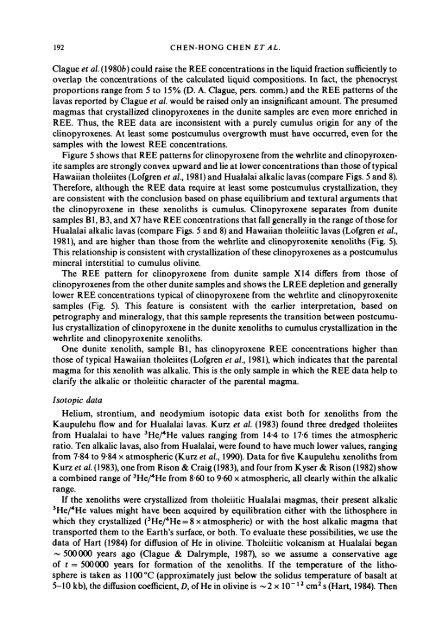Petrogenesis of Ultramafic Xenoliths from the 1800 Kaupulehu Flow ...
Petrogenesis of Ultramafic Xenoliths from the 1800 Kaupulehu Flow ...
Petrogenesis of Ultramafic Xenoliths from the 1800 Kaupulehu Flow ...
You also want an ePaper? Increase the reach of your titles
YUMPU automatically turns print PDFs into web optimized ePapers that Google loves.
192 CHEN-HONG CHEN ET AL.Clague et al. (19806) could raise <strong>the</strong> REE concentrations in <strong>the</strong> liquid fraction sufficiently tooverlap <strong>the</strong> concentrations <strong>of</strong> <strong>the</strong> calculated liquid compositions. In fact, <strong>the</strong> phenocrystproportions range <strong>from</strong> 5 to 15% (D. A. Clague, pers. comm.) and <strong>the</strong> REE patterns <strong>of</strong> <strong>the</strong>lavas reported by Clague et al. would be raised only an insignificant amount. The presumedmagmas that crystallized clinopyroxenes in <strong>the</strong> dunite samples are even more enriched inREE. Thus, <strong>the</strong> REE data are inconsistent with a purely cumulus origin for any <strong>of</strong> <strong>the</strong>clinopyroxenes. At least some postcumulus overgrowth must have occurred, even for <strong>the</strong>samples with <strong>the</strong> lowest REE concentrations.Figure 5 shows that REE patterns for clinopyroxene <strong>from</strong> <strong>the</strong> wehrlite and clinopyroxenitesamples are strongly convex upward and lie at lower concentrations than those <strong>of</strong> typicalHawaiian tholeiites (L<strong>of</strong>gren et al, 1981) and Hualalai alkalic lavas (compare Figs. 5 and 8).Therefore, although <strong>the</strong> REE data require at least some postcumulus crystallization, <strong>the</strong>yare consistent with <strong>the</strong> conclusion based on phase equilibrium and textural arguments that<strong>the</strong> clinopyroxene in <strong>the</strong>se xenoliths is cumulus. Clinopyroxene separates <strong>from</strong> dunitesamples Bl, B3, and X7 have REE concentrations that fall generally in <strong>the</strong> range <strong>of</strong> those forHualalai alkalic lavas (compare Figs. 5 and 8) and Hawaiian tholeiitic lavas (L<strong>of</strong>gren et al,1981), and are higher than those <strong>from</strong> <strong>the</strong> wehrlite and clinopyroxenite xenoliths (Fig. 5).This relationship is consistent with crystallization <strong>of</strong> <strong>the</strong>se clinopyroxenes as a postcumulusmineral interstitial to cumulus olivine.The REE pattern for clinopyroxene <strong>from</strong> dunite sample X14 differs <strong>from</strong> those <strong>of</strong>clinopyroxenes <strong>from</strong> <strong>the</strong> o<strong>the</strong>r dunite samples and shows <strong>the</strong> LREE depletion and generallylower REE concentrations typical <strong>of</strong> clinopyroxene <strong>from</strong> <strong>the</strong> wehrlite and clinopyroxenitesamples (Fig. 5). This feature is consistent with <strong>the</strong> earlier interpretation, based onpetrography and mineralogy, that this sample represents <strong>the</strong> transition between postcumuluscrystallization <strong>of</strong> clinopyroxene in <strong>the</strong> dunite xenoliths to cumulus crystallization in <strong>the</strong>wehrlite and clinopyroxenite xenoliths.One dunite xenolith, sample Bl, has clinopyroxene REE concentrations higher thanthose <strong>of</strong> typical Hawaiian tholeiites (L<strong>of</strong>gren et al, 1981), which indicates that <strong>the</strong> parentalmagma for this xenolith was alkalic. This is <strong>the</strong> only sample in which <strong>the</strong> REE data help toclarify <strong>the</strong> alkalic or tholeiitic character <strong>of</strong> <strong>the</strong> parental magma.Isotopic dataHelium, strontium, and neodymium isotopic data exist both for xenoliths <strong>from</strong> <strong>the</strong><strong>Kaupulehu</strong> flow and for Hualalai lavas. Kurz et al. (1983) found three dredged tholeiites<strong>from</strong> Hualalai to have 3 He/ 4 He values ranging <strong>from</strong> 14-4 to 17-6 times <strong>the</strong> atmosphericratio. Ten alkalic lavas, also <strong>from</strong> Hualalai, were found to have much lower values, ranging<strong>from</strong> 7-84 to 9-84 x atmospheric (Kurz et al, 1990). Data for five <strong>Kaupulehu</strong> xenoliths <strong>from</strong>Kurz et al. (1983), one <strong>from</strong> Rison & Craig (1983), and four <strong>from</strong> Kyser & Rison (1982) showa combined range <strong>of</strong> 3 He/*He <strong>from</strong> 8-60 to 9-60 x atmospheric, all clearly within <strong>the</strong> alkalicrange.If <strong>the</strong> xenoliths were crystallized <strong>from</strong> tholeiitic Hualalai magmas, <strong>the</strong>ir present alkalic3 He/ 4 He values might have been acquired by equilibration ei<strong>the</strong>r with <strong>the</strong> lithosphere inwhich <strong>the</strong>y crystallized ( 3 He/ 4 He = 8 x atmospheric) or with <strong>the</strong> host alkalic magma thattransported <strong>the</strong>m to <strong>the</strong> Earth's surface, or both. To evaluate <strong>the</strong>se possibilities, we use <strong>the</strong>data <strong>of</strong> Hart (1984) for diffusion <strong>of</strong> He in olivine. Tholeiitic volcanism at Hualalai began~ 500000 years ago (Clague & Dalrymple, 1987), so we assume a conservative age<strong>of</strong> t = 500000 years for formation <strong>of</strong> <strong>the</strong> xenoliths. If <strong>the</strong> temperature <strong>of</strong> <strong>the</strong> lithosphereis taken as 1100°C (approximately just below <strong>the</strong> solidus temperature <strong>of</strong> basalt at5-10 kb), <strong>the</strong> diffusion coefficient, D.<strong>of</strong>He in olivine is ~2x 10" 12 cm 2 s(Hart, 1984). Then
















